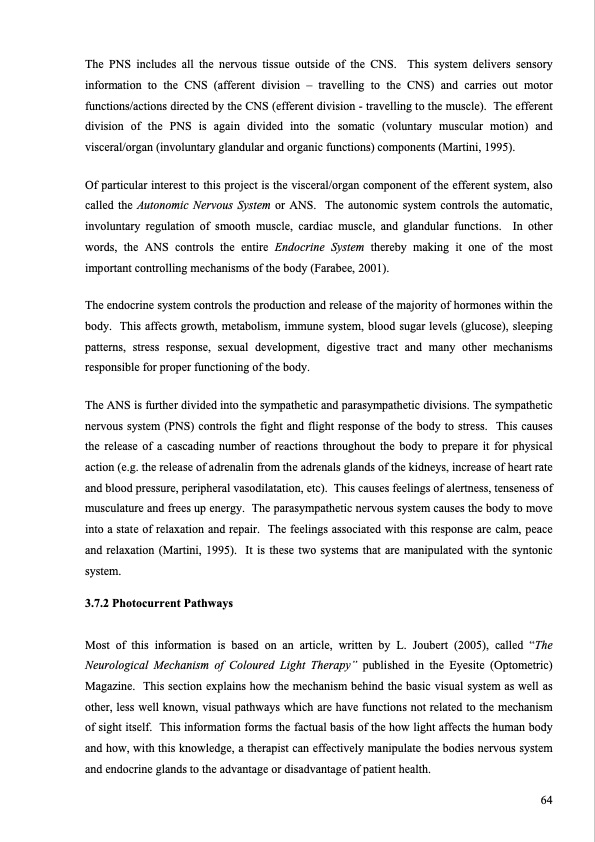
PDF Publication Title:
Text from PDF Page: 077
The PNS includes all the nervous tissue outside of the CNS. This system delivers sensory information to the CNS (afferent division – travelling to the CNS) and carries out motor functions/actions directed by the CNS (efferent division - travelling to the muscle). The efferent division of the PNS is again divided into the somatic (voluntary muscular motion) and visceral/organ (involuntary glandular and organic functions) components (Martini, 1995). Of particular interest to this project is the visceral/organ component of the efferent system, also called the Autonomic Nervous System or ANS. The autonomic system controls the automatic, involuntary regulation of smooth muscle, cardiac muscle, and glandular functions. In other words, the ANS controls the entire Endocrine System thereby making it one of the most important controlling mechanisms of the body (Farabee, 2001). The endocrine system controls the production and release of the majority of hormones within the body. This affects growth, metabolism, immune system, blood sugar levels (glucose), sleeping patterns, stress response, sexual development, digestive tract and many other mechanisms responsible for proper functioning of the body. The ANS is further divided into the sympathetic and parasympathetic divisions. The sympathetic nervous system (PNS) controls the fight and flight response of the body to stress. This causes the release of a cascading number of reactions throughout the body to prepare it for physical action (e.g. the release of adrenalin from the adrenals glands of the kidneys, increase of heart rate and blood pressure, peripheral vasodilatation, etc). This causes feelings of alertness, tenseness of musculature and frees up energy. The parasympathetic nervous system causes the body to move into a state of relaxation and repair. The feelings associated with this response are calm, peace and relaxation (Martini, 1995). It is these two systems that are manipulated with the syntonic system. 3.7.2 Photocurrent Pathways Most of this information is based on an article, written by L. Joubert (2005), called “The Neurological Mechanism of Coloured Light Therapy” published in the Eyesite (Optometric) Magazine. This section explains how the mechanism behind the basic visual system as well as other, less well known, visual pathways which are have functions not related to the mechanism of sight itself. This information forms the factual basis of the how light affects the human body and how, with this knowledge, a therapist can effectively manipulate the bodies nervous system and endocrine glands to the advantage or disadvantage of patient health. 64PDF Image | THE USE OF LIGHT AND COLOUR AS A HEALING MODALITY

PDF Search Title:
THE USE OF LIGHT AND COLOUR AS A HEALING MODALITYOriginal File Name Searched:
light-healing-modality.pdfDIY PDF Search: Google It | Yahoo | Bing
Cruise Ship Reviews | Luxury Resort | Jet | Yacht | and Travel Tech More Info
Cruising Review Topics and Articles More Info
Software based on Filemaker for the travel industry More Info
The Burgenstock Resort: Reviews on CruisingReview website... More Info
Resort Reviews: World Class resorts... More Info
The Riffelalp Resort: Reviews on CruisingReview website... More Info
| CONTACT TEL: 608-238-6001 Email: greg@cruisingreview.com | RSS | AMP |